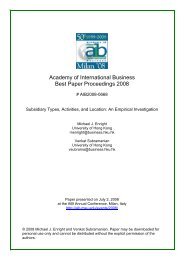AIB 2012 Conference Proceedings - Academy of International ...
AIB 2012 Conference Proceedings - Academy of International ...
AIB 2012 Conference Proceedings - Academy of International ...
Create successful ePaper yourself
Turn your PDF publications into a flip-book with our unique Google optimized e-Paper software.
SUNDAY<br />
and general economic output. (For more information, please contact: Philip Kappen, Uppsala University,<br />
Sweden: philip.kappen@fek.uu.se)<br />
A Conceptual Positioning Matrix for Firms in Developing Countries - Case <strong>of</strong> India<br />
Ajay Kumar Singal, Indian Institute <strong>of</strong> Management, Lucknow<br />
Arun Kumar Jain, Indian Institute <strong>of</strong> Management, Lucknow<br />
Understanding and mapping global competitiveness <strong>of</strong> firms in emerging markets has been a burning issue for<br />
scholars and consultants in recent times. McKinsey suggested ‘strategic control map' (SCM) that looked at<br />
market capitalization - using two parameters <strong>of</strong> book equity (size) and price to book ratio (performance) – as<br />
key driver <strong>of</strong> competitiveness <strong>of</strong> firms. However, this mapping leaves important gaps. SCM, formulated with a<br />
developed market focus, is not suitable in emerging market context and does not consider internationalization<br />
as a key driver. In this paper, we suggest a fresh framework ‘Global Competitiveness Matrix' (GCM) to further<br />
augment the understanding about relative comparison <strong>of</strong> competitiveness <strong>of</strong> firms in emerging markets and<br />
developed contexts. Using the case <strong>of</strong> large cap firms based in India, we argue that ‘international intensity' and<br />
market capitalization can be important measures to map the relative paths <strong>of</strong> growth. The paper also provides<br />
important leads for further research. Keywords: Global Competitiveness Matrix (GCM), <strong>International</strong>ization,<br />
Vulnerability (For more information, please contact: Ajay Kumar Singal, Indian Institute <strong>of</strong> Management,<br />
Lucknow, India: ajay.singal@iiml.ac.in)<br />
<strong>International</strong> Location Decisions <strong>of</strong> Companies from Emerging Countries: When and How Distance Matters<br />
Claudio Ramos Conti, EBAPE- Fundação Getúlio Vargas<br />
Flávio Carvalho de Vasconcelos, EBAPE - Fundação Getúlio Vargas<br />
Ronaldo Parente, Florida <strong>International</strong> University<br />
We study the use <strong>of</strong> distance for international location decisions <strong>of</strong> companies from emerging countries, which<br />
have a growing importance for the world economy. In light <strong>of</strong> a call for scholars to study when and how<br />
distance matters, we investigate the circumstances under which distance matters the most, some <strong>of</strong> which<br />
atypical for companies from emerging economies. We propose that distance matters the most: (1) when the<br />
company is private-owned (as opposed to state-owned); (2) when its internationalization motive is marketseeking<br />
(rather than asset-seeking); (3) when it occurred in the first internationalization wave, in the 1970`s<br />
and 1980`s (instead <strong>of</strong> in the second internationalization wave, starting from the 1990`s); and (4) when it<br />
operates in services, low-technology industries (as opposed to manufacturing, high-technology, commodities<br />
and luxury industries). As most <strong>of</strong> these circumstances under which distance matters the most are typical <strong>of</strong> the<br />
internationalization <strong>of</strong> companies from developed countries, we also propose that: (5) distance is less important<br />
in the case <strong>of</strong> companies from emerging countries. With regard to how distance matters for international<br />
location decisions, we argue that it represents the disadvantages <strong>of</strong> the host countries and propose that: (6) it<br />
should be used in conjunction with factors that represent host country attractiveness. (For more information,<br />
please contact: Claudio Ramos Conti, EBAPE- Fundação Getúlio Vargas, Brazil: claudio_conti@hotmail.com)<br />
Developing DMNCs' Learning Capabilities: From a Coopetition Perspective<br />
Fiona Xiaoying Ji, Kean University<br />
Manisha Singal, Virginia Polytechnic Institute and State University<br />
While the importance <strong>of</strong> international alliances has long been recognized in traditional multinational corporations<br />
(MNCs), its effects on MNCs from developing countries (DMNCs) learning and ultimately DMNCs growth remains<br />
undeveloped. In this paper, by building on the literature about coopetition, defined as simultaneously<br />
cooperation and competition as well as organizational learning, we identify and discuss factors influencing<br />
international learning decision and the effectiveness <strong>of</strong> such learning for DMNCs' international growth. Our<br />
multi-level conceptual model incorporates dyadic coopetition with foreign partners and geographic coopetition<br />
<strong>AIB</strong> <strong>2012</strong> <strong>Conference</strong> <strong>Proceedings</strong><br />
Page 93

















